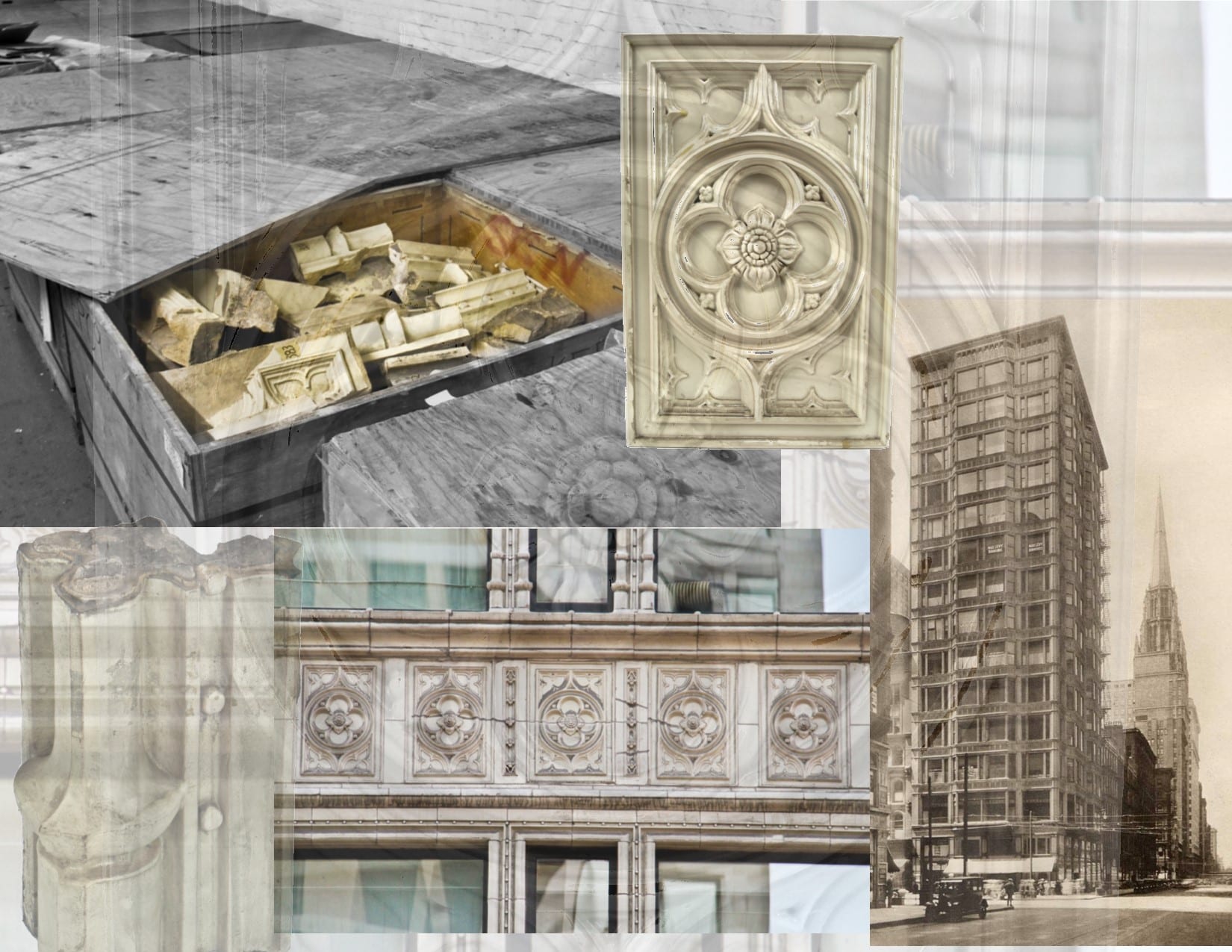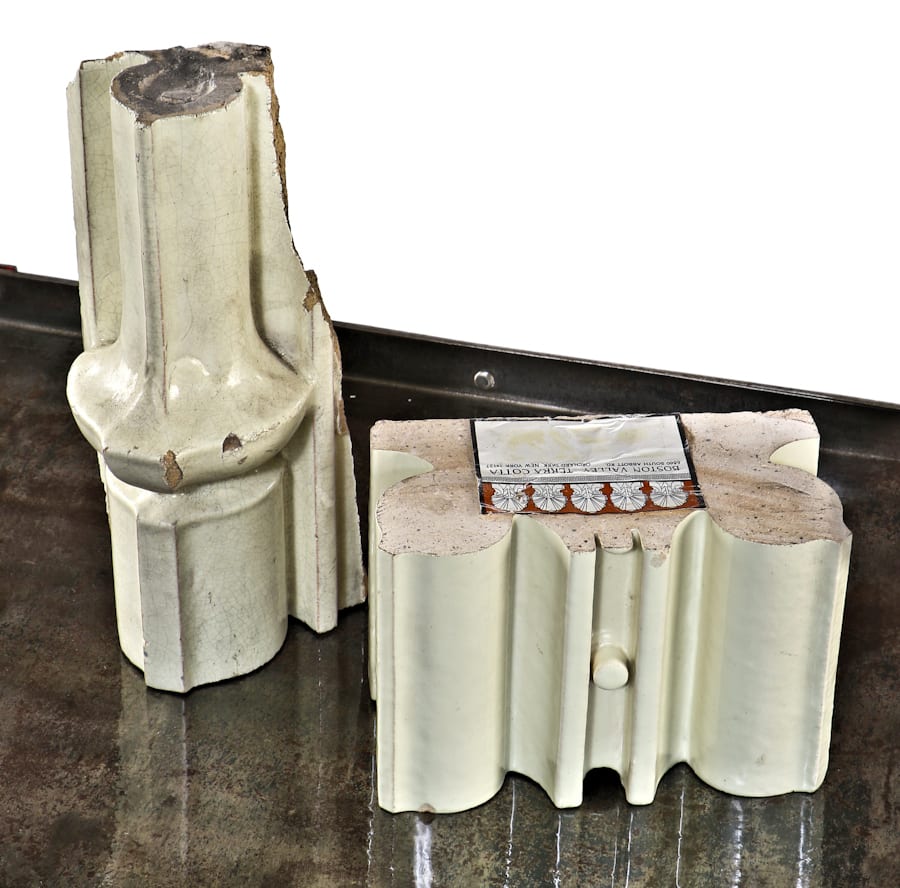reliance building facade terra cotta was crated, stored and forgotten for over 16 years
This entry was posted on March 10 2020 by Eric

one day i received a call from the general manager at hotel burnham (named after notable chicago architect daniel burnham), which is downtown chicago hotel that currently occupies the reliance building, completed march, 1895. prior to being converted into a boutique hotel, the building sat largely abandoned, the upper floors containing only a few transient tenants in dimly lit, crumbling offices. even worse, the gothic style cream-colored terra cotta facade or "curtain wall," designed by charles atwood, was in desperate need of restoration or at least stabilization. the "elements" had taken their toll on the now-blackened terra cotta ornament, which was cracking every which way from little to no maintenance. adding insult to injury, the entire protruding cornice had been removed and "capped" off with brick and concrete.




the original cornice (since replicated during the facade's restoration) was removed in 1948.

the aforementioned description was but a distant memory by the time i heard from the hotel's manager. after a massive overhaul was completed a few years back to restore the building - inside and out - it was prepared for rebirth as a hotel whose identity was based primarily on the attractive historical attributes the building has to offer.

i had stayed at this hotel on numerous occasions, to spend an evening drifting off and waking up nestled comfortably in this remarkable building, which was once filled primarily with medical practitioners. i would take time to admire the original mahogany wood doors with "florentine" pattern panes of glass containing shadowed lettering of the business, the yale & towne ornamental cast iron hardware, the massive plate glass windows, the original winslow brothers iron staircase with marble treads, and the rebuilt main elevator lobby with an impressive mosaic floor that looked very much like the original. there is no doubt the hotel proudly demonstrated going above and beyond to maintain as much as possible of the original architectural characteristics which made this building notable in the first place. despite being a die-hard purist, i was impressed with the efforts put forth by the developers, architects, and general contractor.





what i didn't know was exactly how much material was carefully removed, documented and placed safely into secure wood crates for storage, which, by the time i arrived was over 15 years later. since they no longer needed any of these materials, there was no reason to continue paying monthly storage, and they figured they would sell off any and all of the crates filled with bits and pieces of the building. this was in order not only to make some extra money, but prevent paying to dispose of the material in several dumpsters. from a business standpoint, it made complete sense. the hotel was finished, looked remarkable and there wasn't any reason to hold onto material they no longer had any use for.


once i secured the deal we brought in moving trucks and transported crate after crate back to the warehouse. there were thousands of door hinges, knobs, sash pulls and other pieces of hardware originally used throughout the building. there was a substantial amount of ornamental ironwork from the original elevators, several doors, and transom or overhead panels. some of the doors contained the original business names on the plate glass. there were piles of r. williamson "schoolhouse" type pendant lights with original glass shades that were used in the offices and hallways - all with original chain, fitters and canopies. the massive gangbox contained an oversized glass encased watthour meter from the gargatuan sub-basement switchboard, along with an ornamental cast iron cutler mail chute box.


finally, there were at least 20 wooden crates stuffed with thousands of individually numbered terra cotta fragments that were removed like rotted cavities only to be replaced with newly cast terra cotta replacements. the list continues, but it makes me wonder how much other material was discarded through the trash chutes as they did a complete gut-rehab from one floor to the next.
according to various sources, there are 140 different decorative motifs out of approximately 14,300 pieces of terra cotta, that were fabricated by northwestern to outfit the reliance building's facade or curtain wall. the first phase of the facade's restoration involved replacing more than 2,000 pieces of terra cotta with nearly identical matches, both in form and glaze color. another thousand pieces were removed from the building, cleaned and reinstalled. thousands more were removed and placed in storage. with the intention that they would never be used again. new molds had to be made for 130 of them of the decorative facade elements. the boston terra cotta company handled the fabrication of the newly added pieces.


earlier this year i had gunny harboe over, and we spent an hour or so talking at length about the reliance building restoration, his involvement with it, and his utter disappointment over how the reliance building remnants in storage were handled. i agreed that at least some of the original elements should have been kept onsite if further restoration efforts and/or repairs were considered, but that was simply out of our hands. i am thankful that the restoration was mostly a success and that the bulk of the materials in storage were offered for sale as opposed to simply tossed in the landfill. gunny was pleased when i offered him a nice fragment (original to construction), which he managed to tuck away in his backpack, despite its hefty weight and awkward shape.

given the circumstances i feel it was a win-win, since the building was brought back to its former glory, and several original elements lost in storage were made available to the general public as collectible artifacts. ultimately, many elements were given a second life in new settings: several doors were incorporated into a newly built commercial building and the cutler mailbox was installed in a hotel that sought period-appropriate artifacts that had been stripped out long ago. restorations of this caliber do not happen often. the most i can do is document events surrounding the acquisition, perhaps shedding light on several historically important artifacts that might well have been forgotten.


This entry was posted in , Miscellaneous, Salvages, Bldg. 51, New Products, Events & Announcements, New Acquisitions, Featured Posts & Bldg. 51 Feed on March 10 2020 by Eric
WORDLWIDE SHIPPING
If required, please contact an Urban Remains sales associate.
NEW PRODUCTS DAILY
Check back daily as we are constantly adding new products.
PREMIUM SUPPORT
We're here to help answer any question. Contact us anytime!
SALES & PROMOTIONS
Join our newsletter to get the latest information






















































